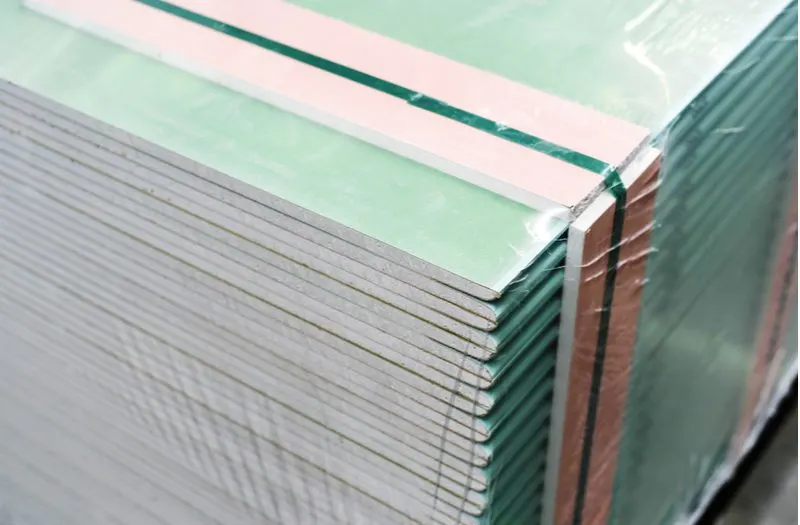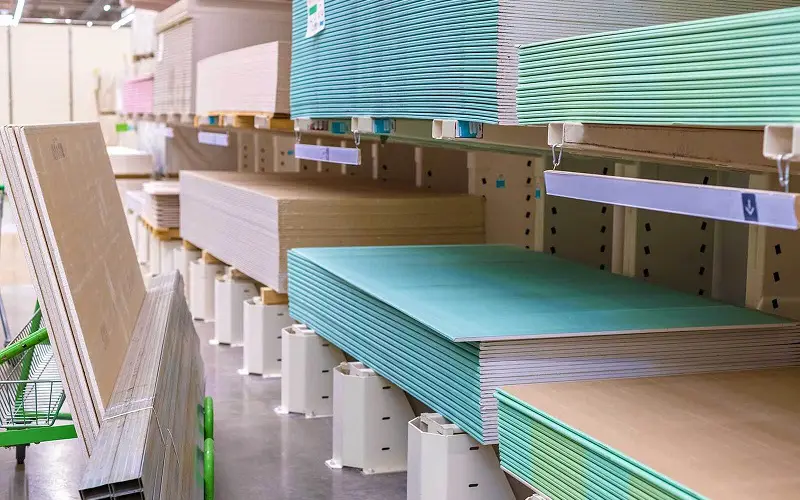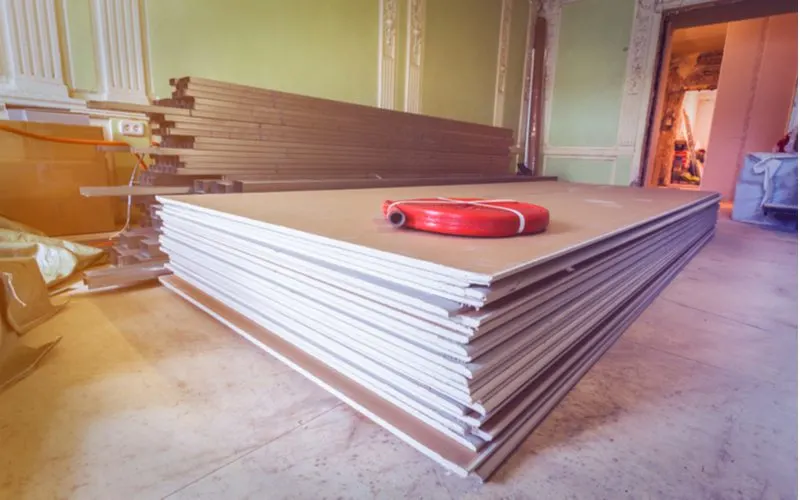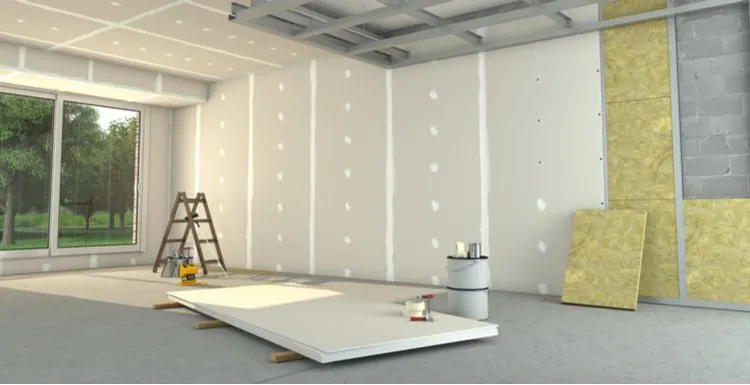It may seem like drywall is the simplest step in construction, but it’s more complicated than you probably think.
Many types of drywall differ in material and purpose.
Choosing the wrong drywall can cause a project to fail right from the beginning. Keep reading for a breakdown of the different types of drywall so you can choose the right one for your job with confidence.
The 13 Types of Drywall and Their Uses

Dmitry Markov152/Shutterstock
To give you an idea of what types of drywall are available to you, we’ve discussed thirteen different options and the best situations to use them in.
Some of these drywalls are all-purpose, while others have specific uses. We’ll discuss the ideal place for each kind of drywall so you know what to use.
1. Standard
Standard drywall is one of the more commonly used types of drywall, but it has the least to offer its users.
Standard drywall, sometimes called whiteboard, is white on one side and brown on the other and comes in a wide range of sizes.
Standard drywall is the cheapest type of drywall, which makes it the most economical. You can use regular drywall in almost any situation. However, it isn’t as durable and resistant as some of the other drywalls we’ll discuss.
Although we will discuss many other drywalls with added features, standard drywall is still widely used and appreciated in most homes. People continue to improve upon the material, but standard drywall is still the most common.
2. Moisture-Resistant
Moisture can cause serious problems if it gets into your drywall. If moisture gets trapped in your drywall, it will deteriorate the material and possibly cause mold.
Now, there are drywalls made to be moisture-resistant. This material is often called green board. It uses the same materials as regular drywall but has an added layer of green plastic that deters water.
Keep in mind that resistant does not mean waterproof. Don’t put this somewhere with direct water contact. Green board is often in kitchens, bathrooms, or basements behind tile that may experience moderate wetness.
3. Mold-Resistant
Mold-resistant drywall is slightly different from moisture-resistant drywall. Also called purple board, this material is mold and moisture-resistant, more so than green board.
You may wonder why both exist, and the answer is that a green board is cheaper.
But if you need drywall that can handle contact with water, a purple board is your best bet. The board has a specially treated gypsum core that is moisture, mold, and fire-resistant, surrounded by durable recycled paper.
Mold and mildew thrive in wet, dark places. Mold in your walls can pose health risks to you and your family, especially if anyone in the household suffers from a respiratory condition such as asthma.
4. Fire-Resistant
Fire-resistant drywall is necessary for some locations that adhere to building codes. Fire-resistant drywall is not fireproof, but it can withstand and relatively contain a fire for about an hour before disintegrating and allowing it to spread.
Fire-resistant drywall is sometimes called Type X drywall. It is the most durable and the hardest type of drywall to work with, as it’s difficult to cut and hammer through. You’re most likely to find it in garages, apartment buildings, and newer houses.
The drywall uses special non-combustible fibers and is often thicker than standard drywall.
The thickness improves the fire rating and the soundproof level. While no place ever plans on having a fire, using these boards often gives people peace of mind.
5. Soundproof
Soundproof drywall is less popular than other types we’ve discussed.
Soundproof drywall is often for very specific places, like recording studios, classrooms, therapy offices, and any location where silence is a priority and noise may be an issue.
People who live near concert venues or in cities will use soundproof drywall to drown out the outside noises, but the drywall is significantly more expensive.
Soundproof drywall uses a mix of wood fibers, gypsum, polymers, and sometimes a thin layer of metal in the middle.
Because the boards are thicker, they are also sturdier than standard drywall and have a decent fire rating, despite the mixture of wood present in the drywall.
6. Eco-Friendly

Viktor Fedorenko/Shutterstock
As the world works toward a more sustainable way of life, more and more eco-friendly drywall comes to the market. One of the best eco-friendly drywalls available today is Eco Rock.
The drywall uses more than twenty different recycled industrial byproducts mixed with fillers and water.
This combination creates drywall resistance to termites and mold. Another eco-friendly option growing in popularity is EnviroBoard.
This drywall consists of agriculture waste fibers, newspaper waste, and more, compressed into sturdy concrete-like panels that help build modern homes.
These boards are perfect for environmentally conscious people and perform just as well as standard drywall, if not better. The main difference is the cost, which is significantly higher as recycled materials are more difficult to acquire.
7. Paperless
It may surprise you that paperless drywall is less eco-friendly than paper drywall. The outer paper layer is a thin layer of fiberglass instead, which is more harmful to the environment.
Paperless drywall is slowly replacing standard paper drywall because it is sturdier, mold-resistant, moisture-resistant, and about the same price.
Some professionals even state the material is easier to cut accurately, making it the preference of both homeowners and contractors.
While paperless drywall is most commonly used in kitchens and bathrooms, people are beginning to use it throughout their houses because of its sturdiness.
8. Plasterboard
Plasterboard, commonly called blue board, is drywall made of paper and plaster. Blue board comes in handy when regular drywall is not durable enough for the project.
However, the blue board is a bit of a disaster if it gets wet at all. The outer paper layer is not waterproof, and if it gets wet, the board disintegrates. Blue boards are like standard drywall with a whole lot of oomph.
The material is more soundproof, resistant to scratches and scuffs, long-lasting, and overall better, aside from its kryptonite: water. Blue boards are commonly used in industrial settings to make buildings extra sturdy and stable.
9. Damage-Resistant
Damage- or abuse-resistant is ideal in high-traffic areas that may experience a lot of wear and tear.
Use this drywall in places like your mudroom, stairwells, restaurants, workshops, garages, and anywhere you may expect the wall to take hits.
The drywall can handle the abuse because it uses a higher wallboard density along with a fiber mesh embedded in the back that combats against warping, cracking, or collapsing.
This drywall is beefed up and costs more than standard drywall, but it’s worth it if it means it will last a long time.
10. Flexible
You may think all drywall is rigid, but there is flexible drywall too. People use flexible drywall for curved walls, archways, and ceilings. This drywall can be bent and curved without cracking, so it holds many creative construction possibilities.
Flexible drywall is most common in hotels, museums, galleries, and other artistic or retail spaces. Flexible drywall has heavier face paper and a tougher liner than standard drywall.
This added strength allows the drywall to flex and bend without cracking. There are also flexible drywalls that use segmented or slotted plaster on the inside, allowing for bending and shaping, but these are relatively new.
11. Lightweight
Lightweight drywall is ideal for ceilings or wall studs because it won’t sag or cave in from weight. These are usually in places that will have a heavy application on top of the drywall that may pull it down.
Lightweight drywall has a significant weight difference, weighing 25% to 45% less than standard drywall, depending on the thickness. With a reinforced gypsum core, lightweight drywall is actually stronger than standard drywall.
12. Foil-backed
A new product that isn’t getting a lot of love in the drywall community, foil-backed drywall is good for places with masonry, steel, and woodwork. Foil-backed drywall is best on the interior faces of exterior walls and ceilings.
The foil back is made from aluminum foil, creates a stronger barrier from outside elements, and can better insulate your home. However, they are not moisture-resistant, so they are not ideal in bathrooms or wet areas.
13. VOC Absorbent
VOCs, or volatile organic compounds, can be found in most households. These compounds can be harmful to your health, but they are almost impossible to avoid.
These compounds come from substances like paint, plaster, and cleaning products—essentially anything with chemicals.
The VOC-absorbent drywall actually absorbs and traps these compounds, neutralizing them forever. The drywall continues to do this even after being plastered, painted, or wallpapered.
Things to Consider

Zakhar Mar/Shutterstock
When choosing the ideal type of drywall for your space, make sure you keep these things in mind.
- Ensure you consider where the drywall will go and if this area has exposure to water, weather, or high traffic.
- While the newer drywall is impressive, you need to consider your budget when choosing drywall and may have to use standard drywall due to cost.
- Listen to contractor or construction worker recommendations, as their experience with different drywalls is useful knowledge.
- Consider the purpose of the room. If it is for a musician, consider soundproofing. If it’s a game or playroom, consider plasterboard. If it’s a moisture-prone space, use the purple or green board.
Frequently Asked Questions
These are frequently asked questions about types of drywall to help you pick the best one for your project:
What’s the best drywall for a bathroom?
The best drywall for a bathroom will be either purple (mold-resistant) or green (moisture-resistant) drywall. The green board can function well in a bathroom, but the purple board is the best choice because it can resist mold and bacteria.
What’s the best drywall for a garage?
Several drywalls discussed would perform well in a garage, such as the fire-resistant, damage-resistant, or plasterboard. However, our recommendation would be the damage-resistant kind, as this board is sturdy and can handle the wear and tear that occurs in a garage.
Which drywall is the cheapest?
Standard drywall is the cheapest, and likely always will be, costing only about $8 to $12 per foot.
Which drywall is the most expensive?
Soundproof drywall is the most expensive, sometimes costing four times more than standard drywall. The price is due to the mix of materials and thickness of the drywall.
Can I use different drywalls throughout my home?
Yes, absolutely. Many people feel like they need to choose drywall for their homes. In reality, you can pick specific drywalls for certain areas in your home, which maximizes the durability of the construction.
What’s the Best Type of Drywall for you?
Now you have a better idea of the different types of drywall available for your home or business. It’s easy to just opt for the standard stuff, but we highly recommend considering drywall geared toward your project.
Before you rush into using just one type, explore all of your options before settling for regular drywall!

